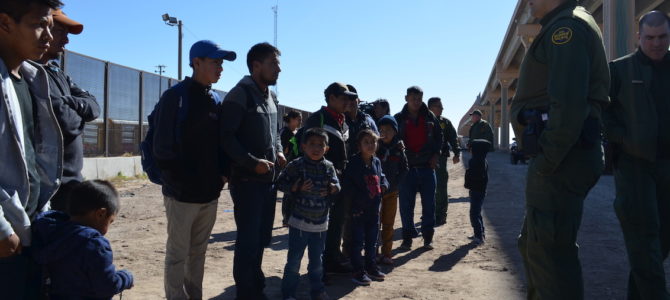
At the end of last year, mainstream media were rife with stories about how President Trump was wrong about the border because, actually, statistics show that illegal immigration levels are at “historic lows.” A headline from a Politico article in November is representative of the genre: “Immigration crisis? The stats tell a different story.”
The story the media thinks the stats tell is that there is no border crisis because the total number of apprehensions along the border peaked in 2000 at about 1.6 million and current illegal immigration levels are about what they were in the 1970s.
But this convoluted talking point is deeply misleading. Border apprehensions are in fact on the rise, on pace to reach their highest levels since 2008. What’s more, the “historic lows” line doesn’t account for the different types of illegal immigration or the very different policies in place to deal with distinctive categories of migrants. Given the reality of what’s happening on the border today, the “historic lows” talking point is almost meaningless.
For example, of those 1.6 million illegal immigrants arrested in 2000, the vast majority were Mexican adults traveling alone, and were quickly deported in accordance with federal law. Historically, most of the illegal immigration along the southern border has consisted of Mexican adults. As recently as 2012, 90 percent of apprehensions along the southern border were single adults. Today, that’s changed. Family units and unaccompanied minors now make up 60 percent of all apprehensions along the southern border.
The change is important because we don’t treat single adults the same way we treat families and minors traveling alone. Instead of detaining or deporting them—as we do with adults—federal immigration officials are releasing families and children into the United States with orders to appear before an immigration judge, a process that can take years.
Simply put, the crisis at the border is real. Even if the total number of apprehensions is down from its peak in 2000, the total number of those apprehended and then released into the U.S. is certainly higher than it was twenty years ago. That’s because unprecedented numbers of Central American families and minors are entering the country and claiming asylum—so many, in fact, that U.S. immigration authorities along the border are overwhelmed, as are local authorities.
Along The Border: Mass Apprehensions, Mass Releases
To get a sense of what the crisis looks like, consider what’s been happening along the border just in the last few days. In the early morning hours of Tuesday, Border Patrol agents in El Paso, Texas, apprehended a group of 194 migrant families and unaccompanied minors. Five minutes later, they encountered a group of 252. In the first three hours of the day, agents had already taken in 430 migrants. The El Paso sector is now averaging 570 apprehensions a day, and at this rate, apprehensions will exceed 200,000 this fiscal year—just for the El Paso sector.
In the Rio Grande Valley, U.S. Border Patrol agents last week apprehended a group of 289, the largest single group encountered in that area so far this year. The Rio Grande Valley has been the busiest sector of the border for illegal crossings in recent years, but it’s getting worse. On a single day last week, agents apprehended 1,000 people. In February, agents apprehended more than 25,000 migrants, most of them families and unaccompanied children.
Federal immigration authorities are now releasing migrants as fast as they are taking them in. The New York Times reported Wednesday that officials in McAllen, Texas, had released more 2,200 people from immigration facilities since Monday (McAllen, it should be noted, is a relatively small town that can’t exactly absorb thousands of new people showing up on its streets in a matter of days).
Mass releases like this are happening all along the border, and cities are struggling to cope with the large numbers of people being discharged from federal custody. On Thursday, Immigration and Customs Enforcement officials said the agency has released more than 107,000 migrant families and children since December 21, and that ICE arrests in the interior of the country are falling as resources are diverted to the border.
In El Paso, ICE plans to release up to 600 migrants a day on Friday, Saturday, and Sunday, which will likely overwhelm already crowded shelters in the city. City officials with El Paso’s Office of Emergency Management on Tuesday were planning to turn a municipal park into an staging ground to house 150 migrants for whom there was no room at local shelters (a local charity was able to secure hotel rooms at the last minute, so the park wasn’t needed).
A Catholic Charities respite center in McAllen that helps migrant families reported that it received more than 800 migrants on Monday, 800 on Tuesday and more than 600 on Wednesday afternoon. Sister Norma Pimentel, the executive director of Catholic Charities of the Rio Grande Valley, said Border Patrol told her to expect about 800 people a day for an unspecified period of time. For comparison, when I visited the respite center around this time last year, it was only receiving between 60 and 120 migrants a day.
The Border Crisis Is Real, Complicated, and Getting Worse
News that more than 76,000 migrants were apprehended on the southern border in February, an 11-year high, should have been enough to put the “historic lows” talking point to rest. Now, as the trend continues through March and likely into April, it’s time to face the reality, which is this: although total numbers of apprehensions might still be lower than they were in 2000, the total number of migrants being released into the United States, instead of deported or detained, is almost certainly higher today.
The arrival of mass numbers of families and minors claiming asylum has exposed profound problems in our immigration system for which there are no easy solutions. Almost everywhere one looks, there are problems. Border Patrol and ICE facilities were never built to house families and children. Border fencing or a wall will not stop families and children from crossing into the United States and claiming asylum. Federal immigration courts face a backlog of more than 800,000 cases, which means asylum-seekers can wait years for a hearing.
The border crisis is real, it’s complicated, and it’s getting worse. It’s time to stop repeating, mantra-like, the meaningless talking point that illegal immigration levels are at “historic lows.”









